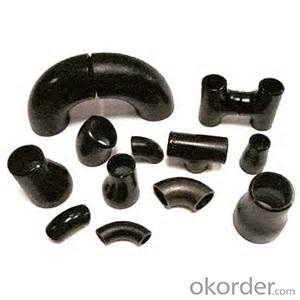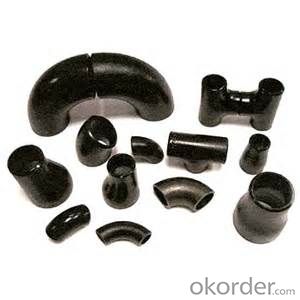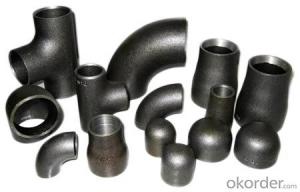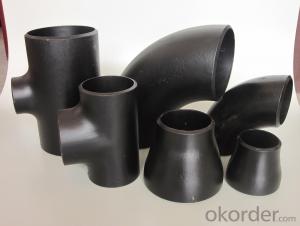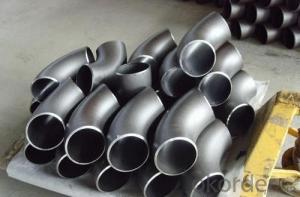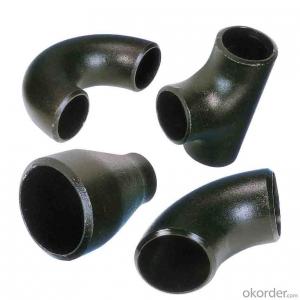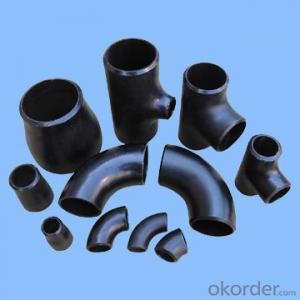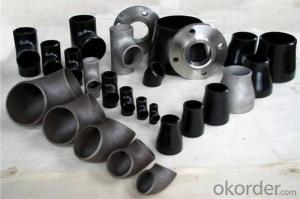2'' -12'' CNBM carbon steel pipe fittings ISO/ BS EN/DIN/ API
- Loading Port:
- Tianjin
- Payment Terms:
- TT OR LC
- Min Order Qty:
- 5 m.t
- Supply Capability:
- 300 m.t/month
OKorder Service Pledge
OKorder Financial Service
You Might Also Like
Products Detailed Description
Products | pipe fittings elbows, bends,tees, reducers caps |
Size | 1/2" - 48" |
Wall thickness | Sch5-Sch160 XXS |
Standard | ANSI, ASME API5L, OCT, DIN and JIS, etc. |
we can also produce according to drawing and standards provided by customers. | |
Material | Carbon steel, alloy steel and stainless steel. |
We can produce according to materials appointed by consumers. | |
Packaging | Plywood Cases,plywood pallet, plastic bag or as customers requirement |
Surface Treatment | Shot blasted, rust-proof black oil |
Delivery Time | 10-60 days |
Quality | First grade |
Others | 1.Special design available according to your drawing. |
2.anti-corrosion and high-temperature resistant with black painting | |
3. All the production process are made under the ISO9001:2000 strictly. | |
4. A conformity rate of ex-factory inspection of products. |
Specifications
Ansi B16.9 WPB carbon steel pipe fitting elbow tee reducer
Size:Seamless 1/2"-24" Welded 1/2"-48"
ANSI B16.9 WPB carbon steel pipe fitting elbow tee reducer
1.Size: Seamless 1/2"-24" Welded 1/2"-48"
2. WT: SGP, STD, SCH40, SCH80, SCH100,SCH120,SCH160,XS,XXS
3. Material:
stainless steel Grade: 201,304,304L,316,316L,317,317L,904L,and etc
carbon steel Grade: WPB,GRB, Q235,16MN
Alloy steel: st35.8,st52,wp11,wp22,wp12 wp l6
4. Standard: ASTM/AISI/DIN/JIS
5. Type: Concentric and eccentric
6. Surface treatment: Transparent oil, rust-proof black oil
7. Applications range: Applications range: for use in the petroleum, smelting, foodstuff, power, papermaking, chemical, medical equipment,aviation, boiler heat exchanger, and other fields
8. Packing: wooden case or as per customers' requirement
- Q: What are the advantages of using steel pipes over other materials?
- There are several advantages of using steel pipes over other materials. Firstly, steel pipes are incredibly durable and have a high tensile strength, making them resistant to extreme temperatures, pressure, and corrosion. Secondly, steel pipes have excellent structural integrity, allowing for longer spans and fewer supports. Additionally, steel pipes are highly versatile and can be easily welded, threaded, or joined, making installation and maintenance easier. Lastly, steel pipes are cost-effective in the long run as they require minimal maintenance and have a longer lifespan compared to other materials.
- Q: Can steel pipes be used for geothermal heating systems?
- Yes, steel pipes can be used for geothermal heating systems. Steel is a commonly used material in geothermal installations due to its durability, corrosion resistance, and ability to withstand high temperatures. It provides a reliable and long-lasting solution for transferring heat in geothermal heating systems.
- Q: How are steel pipes threaded?
- Steel pipes can be threaded using a process called threading. Threading is the process of creating screw-like grooves on the outer surface of the pipe, which allows it to be connected to other pipes or fittings using threaded connections. There are several methods for threading steel pipes, including manual threading, electric threading machines, and hydraulic threading machines. In manual threading, a handheld pipe threading tool called a die is used. The die is placed on the outside of the pipe, and the pipe is rotated while pressure is applied to create the threads. This method is suitable for small diameter pipes and is typically used for on-site repairs or in small-scale operations. Electric threading machines are commonly used for larger diameter pipes. These machines consist of a motor-driven spindle, which rotates the pipe, and a die head that holds the threading dies. The operator simply feeds the pipe into the machine, and the threading dies cut the threads onto the pipe automatically. Hydraulic threading machines are similar to electric threading machines but use hydraulic power to rotate the pipe and create the threads. These machines are typically used for larger diameter pipes or in heavy-duty applications. Regardless of the method used, it is important to ensure that the pipe is properly prepared before threading. This may involve cleaning the pipe, removing any burrs or sharp edges, and applying a lubricant to reduce friction during the threading process. Overall, threading is a common and efficient method for creating threaded connections on steel pipes. It allows for easy assembly and disassembly of pipes and fittings, making it a popular choice in various industries such as plumbing, construction, and oil and gas.
- Q: What is the difference between ERW (Electric Resistance Welded) and LSAW (Longitudinal Submerged Arc Welded) steel pipes?
- ERW steel pipes are manufactured by high-frequency electrical currents passing through the metal, resulting in a welded joint. On the other hand, LSAW steel pipes are produced by submerging a metal plate into a welding zone, creating a welded joint through the use of a welding arc. The main difference lies in the welding process, with ERW pipes being more suitable for small to medium-sized diameters, while LSAW pipes are commonly used for larger diameter and thicker-walled applications.
- Q: How are steel pipes used in the automotive exhaust systems?
- Steel pipes are commonly used in automotive exhaust systems because steel is a durable and heat-resistant material. Steel pipes are used to transport the exhaust gases from the engine to the muffler and tailpipe, ensuring that the gases are safely and efficiently expelled from the vehicle. These pipes are designed to withstand high temperatures, corrosion, and vibration, making them an essential component in the exhaust system.
- Q: What is the difference between steel pipe and copper pipe?
- The main difference between steel pipe and copper pipe lies in their composition and properties. Steel pipe is typically made from carbon steel, which is an alloy of iron and carbon. On the other hand, copper pipe is made from copper, a naturally occurring metal. One key difference is their durability. Steel pipe is known for its strength and resilience, making it suitable for high-pressure applications and harsh environments. It is highly resistant to corrosion, making it a long-lasting option. Copper pipe, on the other hand, is known for its malleability and ease of installation. It is less durable than steel and can corrode over time, especially when exposed to certain chemicals or aggressive water conditions. Another difference is their thermal conductivity. Copper pipe is an excellent conductor of heat, making it ideal for applications that require efficient heat transfer, such as in plumbing systems for hot water supply. Steel pipe, however, has a lower thermal conductivity compared to copper, which may affect its performance in certain applications. Cost is another factor to consider. Copper pipe is generally more expensive than steel pipe due to the higher cost of copper as a raw material. Additionally, copper pipe requires specialized tools and techniques for installation, which can add to the overall cost. Steel pipe, on the other hand, is often more cost-effective and easier to work with, making it a popular choice for a wide range of applications. In summary, the main differences between steel pipe and copper pipe are their composition, durability, thermal conductivity, and cost. Each type has its own advantages and disadvantages, and the choice between them depends on the specific requirements of the application at hand.
- Q: What are the safety measures to be followed while working with steel pipes?
- There are several safety measures that should be followed while working with steel pipes. Firstly, it is important to wear appropriate personal protective equipment (PPE) such as safety glasses, gloves, and steel-toed boots to protect against potential hazards. Secondly, workers should be cautious of sharp edges or burrs on the pipes and handle them with care to avoid cuts or injuries. Additionally, proper lifting techniques should be employed when moving heavy steel pipes to prevent strains or back injuries. It is also crucial to secure pipes properly during transport or storage to prevent accidents. Finally, workers should be trained on the safe use of tools and equipment associated with steel pipe work to minimize the risk of accidents or damage.
- Q: Can steel pipes be used for underground drainage?
- Yes, steel pipes can be used for underground drainage. Steel pipes are commonly used for drainage systems due to their durability, strength, and resistance to corrosion. They are able to withstand heavy loads and can be installed in various soil conditions. However, it is important to ensure proper coating and maintenance to prevent rusting and deterioration over time.
- Q: How are steel pipes protected against microbial corrosion?
- Steel pipes are protected against microbial corrosion through various methods, such as applying protective coatings or linings on the pipes' inner and outer surfaces. These coatings act as a barrier, preventing the contact of microorganisms with the steel surface, thereby reducing the risk of microbial corrosion. Additionally, biocides and inhibitors can be added to the pipe's contents or injected into the pipeline to inhibit the growth and activity of microbes, further protecting the steel pipes from microbial corrosion.
- Q: Are steel pipes environmentally friendly?
- There are several reasons why steel pipes can be considered environmentally friendly. To begin with, steel is an incredibly durable and long-lasting material, giving steel pipes a longer lifespan in comparison to plastic pipes and other materials. This reduces the need for frequent replacements and repairs, resulting in less waste and conservation of resources. Another point to consider is that steel is highly recyclable. When steel pipes reach the end of their lifespan, they can be easily and efficiently recycled without losing their properties or quality. This reduces the demand for new steel production, which often requires substantial amounts of energy and resources. Moreover, steel pipes possess a high resistance to corrosion, meaning that they necessitate fewer chemical treatments to prevent rusting and maintain their structural integrity. Consequently, this diminishes the release of harmful chemicals into the environment and minimizes the impact on ecosystems and human health. Additionally, it is important to highlight that steel pipes find application in various industries, including water supply and wastewater management. Renowned for their exceptional strength and reliability, steel pipes ensure the safe and efficient transportation of fluids. This lowers the risk of leaks and spills, averting water source contamination and safeguarding the environment. Nevertheless, it is crucial to acknowledge that the production of steel pipes does have some environmental consequences. The extraction of raw materials, such as iron ore and coal, demands energy and can contribute to deforestation, habitat destruction, and greenhouse gas emissions. Additionally, the manufacturing process itself generates emissions and waste. Overall, although steel pipes are not entirely devoid of environmental impact, their durability, recyclability, and resistance to corrosion make them a comparatively environmentally friendly choice when compared to alternative materials.
Send your message to us
2'' -12'' CNBM carbon steel pipe fittings ISO/ BS EN/DIN/ API
- Loading Port:
- Tianjin
- Payment Terms:
- TT OR LC
- Min Order Qty:
- 5 m.t
- Supply Capability:
- 300 m.t/month
OKorder Service Pledge
OKorder Financial Service
Similar products
Hot products
Hot Searches
Related keywords
